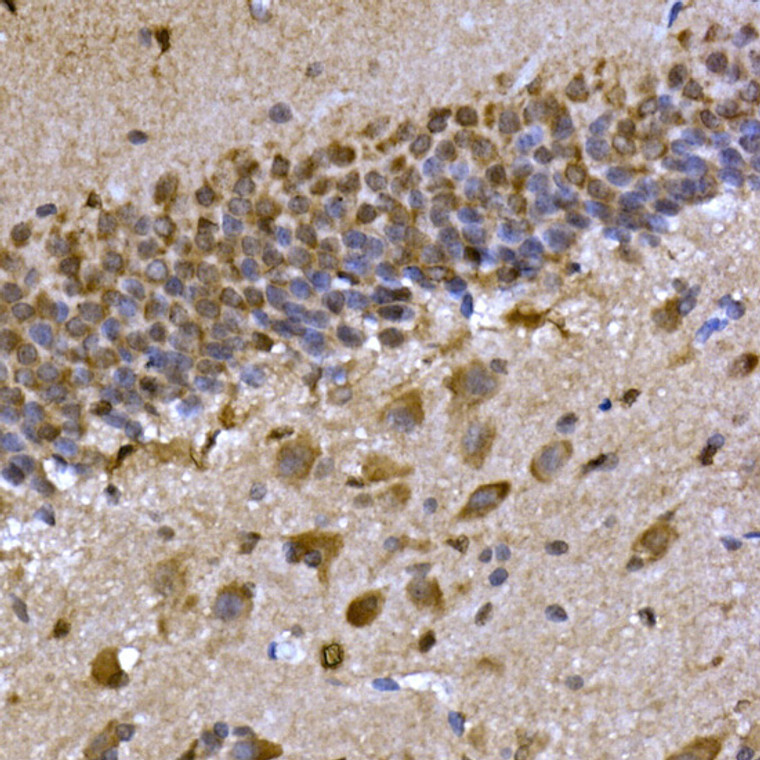| Host: |
Rabbit |
| Applications: |
WB/IHC-P/IF/ICC/ELISA |
| Reactivity: |
Human/Mouse/Rat |
| Note: |
STRICTLY FOR FURTHER SCIENTIFIC RESEARCH USE ONLY (RUO). MUST NOT TO BE USED IN DIAGNOSTIC OR THERAPEUTIC APPLICATIONS. |
| Clonality: |
Polyclonal |
| Conjugation: |
Unconjugated |
| Isotype: |
IgG |
| Formulation: |
PBS with 0.05% Proclin300, 50% Glycerol, pH 7.3. |
| Purification: |
Affinity purification |
| Concentration: |
Lot specific |
| Dilution Range: |
WB:1:200-1:2000IHC-P:1:100-1:500IF/ICC:1:50-1:200ELISA:Recommended starting concentration is 1 Mu g/mL. Please optimize the concentration based on your specific assay requirements. |
| Storage Instruction: |
Store at-20°C for up to 1 year from the date of receipt, and avoid repeat freeze-thaw cycles. |
| Gene Symbol: |
CPEB3 |
| Gene ID: |
22849 |
| Uniprot ID: |
CPEB3_HUMAN |
| Immunogen Region: |
150-400 |
| Specificity: |
Recombinant fusion protein containing a sequence corresponding to amino acids 150-400 of human CPEB3 (NP_055727.3). |
| Immunogen Sequence: |
TFSPQIGLAQTQHHQQPPPP APAPQPAQPAQPPQAQPPQQ RRSPASPSQAPYAQRSAAAA YGHQPIMTSKPSSSSAVAAA AAAAAASSASSSWNTHQSVN AAWSAPSNPWGGLQAGRDPR RAVGVGVGVGVGVPSPLNPI SPLKKPFSSNVIAPPKFPRA APLTSKSWMEDNAFRTDNGN NLLPFQDRSRPYDTFNLHSL ENSLMDMIRTDHEPLKGKHY PPSGPPMSFADIMWRNHFA |
| Post Translational Modifications | Activated by NEURL1-mediated monoubiquitination, resulting in the growth of new dendritic spines and increased levels of GRIA1 and GRIA2. NEURL1-mediated monoubiquitination facilitates synaptic plasticity and hippocampal-dependent memory storage. Under basal unstimulated conditions when CPEB3 is mainly unaggregated, sumoylated and acts as a translational repressor. Following neuronal stimulation, becomes desumoylated and aggregated which is required for the translation of mRNA targets and for dendritic filopodia formation. Following neuronal stimulation, cleaved by CAPN2 which abolishes its translational repressor activity, leading to translation of CPEB3 target mRNAs. Phosphorylation is enhanced by neuronal stimulation. |
| Function | Sequence-specific RNA-binding protein which acts as a translational repressor in the basal unstimulated state but, following neuronal stimulation, acts as a translational activator. In contrast to CPEB1, does not bind to the cytoplasmic polyadenylation element (CPE), a uridine-rich sequence element within the mRNA 3'-UTR, but binds to a U-rich loop within a stem-loop structure. Required for the consolidation and maintenance of hippocampal-based long term memory. In the basal state, binds to the mRNA 3'-UTR of the glutamate receptors GRIA2/GLUR2 mRNA and negatively regulates their translation. Also represses the translation of DLG4, GRIN1, GRIN2A and GRIN2B. When activated, acts as a translational activator of GRIA1 and GRIA2. In the basal state, suppresses SUMO2 translation but activates it following neuronal stimulation. Binds to the 3'-UTR of TRPV1 mRNA and represses TRPV1 translation which is required to maintain normal thermoception. Binds actin mRNA, leading to actin translational repression in the basal state and to translational activation following neuronal stimulation. Negatively regulates target mRNA levels by binding to TOB1 which recruits CNOT7/CAF1 to a ternary complex and this leads to target mRNA deadenylation and decay. In addition to its role in translation, binds to and inhibits the transcriptional activation activity of STAT5B without affecting its dimerization or DNA-binding activity. This, in turn, represses transcription of the STAT5B target gene EGFR which has been shown to play a role in enhancing learning and memory performance. In contrast to CPEB1, CPEB2 and CPEB4, not required for cell cycle progression. |
| Protein Name | Cytoplasmic Polyadenylation Element-Binding Protein 3Cpe-Bp3Cpe-Binding Protein 3Hcpeb-3 |
| Cellular Localisation | CytoplasmNucleusSynapseCell ProjectionDendritePostsynaptic DensityPredominantly Cytoplasmic In Unstimulated Neurons But Translocates To The Nucleus Following Neuronal StimulationNuclear Import Is Mediated By Importin Ipo5 |
| Alternative Antibody Names | Anti-Cytoplasmic Polyadenylation Element-Binding Protein 3 antibodyAnti-Cpe-Bp3 antibodyAnti-Cpe-Binding Protein 3 antibodyAnti-Hcpeb-3 antibodyAnti-CPEB3 antibodyAnti-KIAA0940 antibody |
Information sourced from Uniprot.org
12 months for antibodies. 6 months for ELISA Kits. Please see website T&Cs for further guidance










